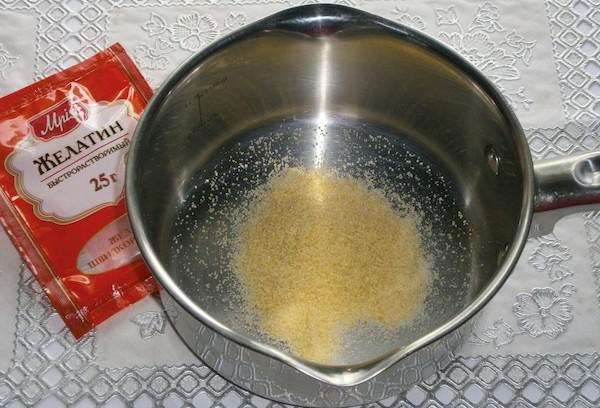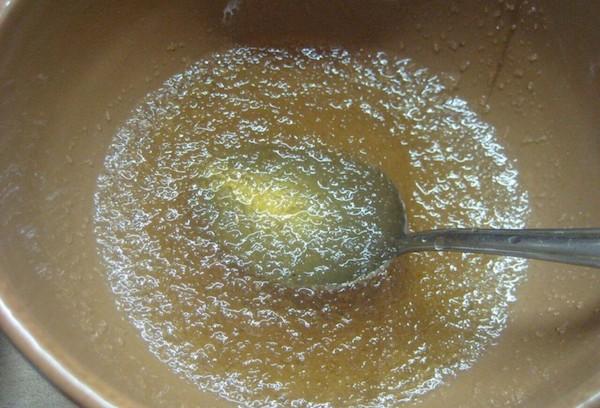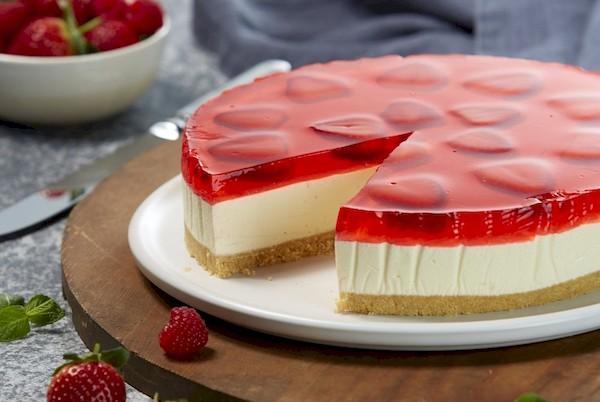How to dilute gelatin for cake and cheesecake: description and step-by-step instructions
Gelatin is an important ingredient in the world of confectionery, used to add structure and elasticity to fillings. But to achieve the desired consistency, you need to know how to dilute gelatin for a cake or other dessert. It's easy to make mistakes in this process, so it's important to follow certain rules.

How to properly dilute gelatin
To dilute the composition, you will need gelatin, water and a container for dilution. Depending on the recipe, you may need to use other ingredients. For example, sugar, fruit juice or other additives may be needed to create a jelly or cream.
To properly dilute gelatin, it is also important to note that you must use cold water, since hot water can destroy its properties.
How to prepare gelatin
Proper preparation before use is key to achieving the desired consistency in desserts and dishes. Here are some features of the preparatory process that should be considered:
- Use only cold water for dilution. Hot will damage its properties.
- Typically, the proportions of gelatin and water for dilution are 1:3. But the exact ratio may vary, so follow the recipe instructions.
- The gelatin should be allowed to soak in cold water for 5-10 minutes before heating it.At this time, it absorbs water and increases its volume, which helps to achieve the desired consistency.
- Stir the substance constantly as you heat it. Gelatin should not boil, as this will destroy its structure.
- The mixture must be completely melted and clear before it is added to the filling or mixture. If it is not completely mixed, its properties may be damaged and the dessert may not have the desired consistency.
- The mixture should not be overheated. As soon as the gelatin has completely melted, you should immediately remove it from the heat and add it to the filling.
Compliance with these features will help to properly prepare the composition for use and achieve the desired consistency of desserts.
How to properly dilute gelatin
The final consistency of many desserts depends on the correct dilution of gelatin:
- Determine the amount of ingredients needed for the recipe. As a rule, the package indicates the ratio of gelatin to liquid required to achieve the desired consistency.
- Measure the required amount and place the ingredient in a small bowl or glass.
- Add cold water to the container in a ratio of 1:3. So, for example, to dissolve 1 tbsp. gelatin will require 3 tbsp. water. It is important to remember that using hot water can damage the substance, so only use cold water.
- Mix the contents of the bowl well until the gelatin is completely covered with water. Let it sit for a few minutes until it swells. This usually takes 5 to 10 minutes.
- After that, put it on low heat and start heating it, stirring constantly. Do not allow it to boil, as this will cause it to lose its properties and consistency.
- Continue heating until mixture is completely melted and clear. This may take about 5 minutes. It must be remembered that gelatin should not bubble or boil.
- Once completely melted, add it to the filling or mixture and stir thoroughly to distribute evenly.
- Pour the contents into a mold or onto a plate and leave to cool.
Proportions of gelatin and water for cake and cheesecake
The proportions of gelatin to water for cake and cheesecake can vary depending on the recipe, but there are a few general guidelines that will help you determine how much gelatin to use:
- To prepare the icing and cream for the cake: usually use 1 packet of gelatin per 100 ml of liquid (water, milk, juice, etc.). The ratio may vary depending on how dense you want the composition to be.
- For cheesecake: the average proportion of gelatin and water is 1 package per 250 g of cream cheese. However, the exact ratio may vary depending on the recipe.
When using gelatin in cake and cheesecake recipes, keep in mind that it can vary in potency depending on the brand and type, so it's always best to follow the recipe instructions. Also, be careful not to go overboard and add too much of this ingredient, as this can result in an unpleasant rubbery texture to your desserts.
How to replace gelatin
If you can't or don't want to use gelatin in your recipes, there are several alternative ingredients that can replace it:
- Corn starch. It can replace gelatin in recipes that require a thick texture, such as puddings and creams.To replace a pack of gelatin, use 1 tablespoon of cornstarch.
- Agar-agar. It is a natural substitute obtained from algae. It has the same gelling power, but contains no animal products, making it suitable for vegan and vegetarian dishes. To replace one package of gelatin, you need to use 1/2 teaspoon of agar-agar.
- Xanthan gum. This is another natural ingredient that can replace gelatin. It is added to the liquid and gives it a thick texture. To replace, use 1/4 teaspoon xanthan gum.
- Pectin. It is a natural thickener obtained from fruits. It is used in recipes for jams, jellies and fruit creams. To replace, use 1 tablespoon of pectin.
If you are substituting gelatin in a recipe, be aware that each of these ingredients has its own characteristics and can affect the texture and taste of the dish. Therefore, it is always best to follow a recipe specifically designed to use substitutes or experiment with substitutions.
Gelatin is an important ingredient in many desserts, but if you can't or don't want to use it, there are always alternatives. Cornstarch, agar agar, xanthan gum and pectin can all replace gelatin, but it is important to consider their specifics and follow the recipe. Don't be afraid to experiment and find your favorite substitutes to make your desserts delicious and healthy.


